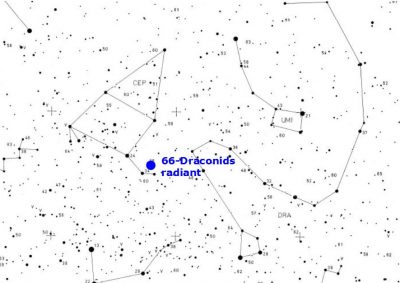An article to be shortly published (Šegon et al., 2016) deals with the association of newly found meteor showers and their possible parent bodies, among which the 66-Draconids meteor shower and asteroid 2001XQ.
According to dynamical modeling results for 2016 by Jérémie Vaubaillon, the 66-Draconids meteor shower might show some enhanced activity on December 2nd (around 21h30m UT) and December 3rd (around 07h00m UT).

The theoritical radiant would be located at RA = 310°, Dec. = +64° position, which locate it between Draco and Cepheus, in a circumpolar position for most mid-Northern latitudes.

It thus lies high in the sky at the beginning of the night, so first potential activity enhancement (Dec. 2, 21h30m UT) will be better observed from Europe and the second (Dec. 3, 07h00m UT) from Western North America. Calculated entry velocity of meteoroids will be close to 21 km/s, leading to slow apparent speed meteors.

No real outburst is predicted, but any reported sign (or absence) of activity from this source would be highly welcome for further studies on the topic.
Thanks in advance, and clear skies!
References:
Šegon D., Vaubaillon J., Gural P., Vida D., Andreić Z., Andreić K., Skokić I., 2016. Dynamical modeling validation of parent bodies associated with newly discovered CMN meteor showers. Astronomy & Astrophysics, in press, DOI: http://dx.doi.org/10.1051/0004-6361/201629100.



 You saw something bright and fast? Like a huge shooting star? Report it: it may be a fireball.
You saw something bright and fast? Like a huge shooting star? Report it: it may be a fireball.  You counted meteors last night? Share your results with us!
You counted meteors last night? Share your results with us!  You took a photo of a meteor or fireball? You have a screenshot of your cam? Share it with us!
You took a photo of a meteor or fireball? You have a screenshot of your cam? Share it with us!  You caught a meteor or fireball on video? Share your video with us!
You caught a meteor or fireball on video? Share your video with us!
3 comments
Together with Ina Rendtel, we observed from a location west of Potsdam, Germany, on Dec 2, 1955-2230UT under good conditions (LM approx 6.3-6.5) and noted ZERO meteors fitting the shower’s radiant and velocity (18 km/s, i.e. very slow). I know of a further report by Christoph Gerber near Heidelberg, Germany, 2135-2155 UT under less favourable conditions – also reporting no meteors of the 66 Draconids.
Jurgen Rendtel – just back from the observing session…
I saw one possible candidate between 21:33 and 23:41 UT, a +4 magnitude meteor at 21:38 UT. The total number of meteors recorded during the session was 21.
A camera in our network detected a possible member on Dec.3 1237UT, -1 mag. But just only one was detected and single station.